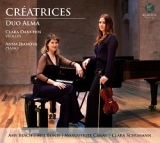Aus dem 19. und der ersten Hälfte des 20. Jahrhundert stammen die vier Werke dieser CD. Die Besetzung für Violine und Klavier aus der Feder von Komponistinnen wird hier durch zwei Sonaten und vier Romanzen, drei davon als zusammengehörende Gruppe, vertreten. Alle Werke strahlen die große persönliche Note ihrer Erschafferin aus. Beispielsweise hat der dritte Satz der Sonate von Mel Bonis einen griechischen Tanz zum Thema. Die Sonate von Marguerite Canal löste bei George Enesco so große Zustimmung aus, der er sie in sein Programm aufnehmen wollte, wozu er nicht kam.
Das Duo Alma setzt sich aus zwei Dozentinnen vom Konservatorium in Toulouse zusammen. Sorgfältig und stimmungsvoll agierend haben sie sich dieser vier Werke angenommen. Es wird schnell deutlich, dass sich hier zwei Künstlerinnen gefunden haben, die in bester Übereinstimmung ihre Sichten auf die Werke zusammenführen, um so über den technischen Rahmen hinaus der Musik eine ansprechende Interpretation zu erschaffen. Dabei lassen sie durchaus die lyrischen Komponenten hören. Da sie die Tempi nicht überreizen, kann sich die Musik entfalten.
The four works on this CD date from the 19th and the first half of the 20th century. Instrumentation for violin and piano penned by women composers is represented here by two sonatas and four romances, three of them as a cohesive group. All of the works exude the great personal character of their creator. For example, the third movement of Mel Bonis’ sonata has a Greek dance as its theme. The sonata by Marguerite Canal aroused such great approval from George Enesco that he wanted to include it in his program, which he did not get to do.
The Duo Alma is composed of two lecturers from the Conservatory in Toulouse. Carefully and atmospherically they have taken on these four works. It quickly becomes clear that two artists have found each other here, who bring together their views of the works in the best possible agreement, in order to be able to give the music an appealing interpretation beyond the technical framework. In doing so, they certainly let the lyrical components be heard. Since they do not overdo the tempi, the music can unfold.
























